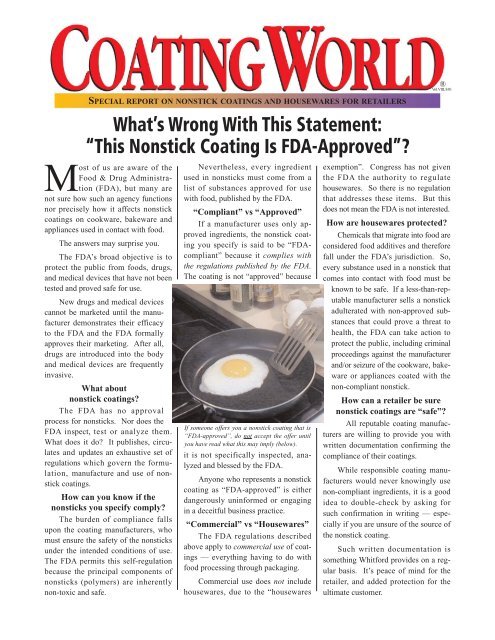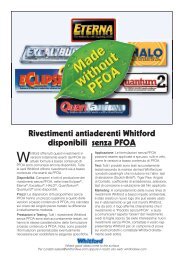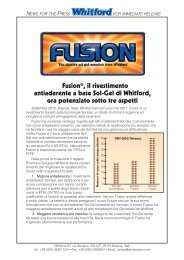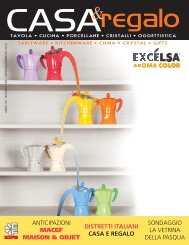Retail CW VIII 8/01 - Whitford Corp
Retail CW VIII 8/01 - Whitford Corp
Retail CW VIII 8/01 - Whitford Corp
Create successful ePaper yourself
Turn your PDF publications into a flip-book with our unique Google optimized e-Paper software.
®Vol.<strong>VIII</strong>, 8/<strong>01</strong>SPECIAL REPORT ON NONSTICK COATINGS AND HOUSEWARES FOR RETAILERSWhat’s Wrong With This Statement:“This Nonstick Coating Is FDA-Approved”?Most of us are aware of theFood & Drug Administration(FDA), but many arenot sure how such an agency functionsnor precisely how it affects nonstickcoatings on cookware, bakeware andappliances used in contact with food.The answers may surprise you.The FDA’s broad objective is toprotect the public from foods, drugs,and medical devices that have not beentested and proved safe for use.New drugs and medical devicescannot be marketed until the manufacturerdemonstrates their efficacyto the FDA and the FDA formallyapproves their marketing. After all,drugs are introduced into the bodyand medical devices are frequentlyinvasive.What aboutnonstick coatings?The FDA has no approvalprocess for nonsticks. Nor does theFDA inspect, test or analyze them.What does it do? It publishes, circulatesand updates an exhaustive set ofregulations which govern the formulation,manufacture and use of nonstickcoatings.How can you know if thenonsticks you specify comply?The burden of compliance fallsupon the coating manufacturers, whomust ensure the safety of the nonsticksunder the intended conditions of use.The FDA permits this self-regulationbecause the principal components ofnonsticks (polymers) are inherentlynon-toxic and safe.Nevertheless, every ingredientused in nonsticks must come from alist of substances approved for usewith food, published by the FDA.“Compliant” vs “Approved”If a manufacturer uses only approvedingredients, the nonstick coatingyou specify is said to be “FDAcompliant”because it complies withthe regulations published by the FDA.The coating is not “approved” becauseIf someone offers you a nonstick coating that is“FDA-approved”, do not accept the offer untilyou have read what this may imply (below).it is not specifically inspected, analyzedand blessed by the FDA.Anyone who represents a nonstickcoating as “FDA-approved” is eitherdangerously uninformed or engagingin a deceitful business practice.“Commercial” vs “Housewares”The FDA regulations describedabove apply to commercial use of coatings— everything having to do withfood processing through packaging.Commercial use does not includehousewares, due to the “housewaresexemption”. Congress has not giventhe FDA the authority to regulatehousewares. So there is no regulationthat addresses these items. But thisdoes not mean the FDA is not interested.How are housewares protected?Chemicals that migrate into food areconsidered food additives and thereforefall under the FDA’s jurisdiction. So,every substance used in a nonstick thatcomes into contact with food must beknown to be safe. If a less-than-reputablemanufacturer sells a nonstickadulterated with non-approved substancesthat could prove a threat tohealth, the FDA can take action toprotect the public, including criminalproceedings against the manufacturerand/or seizure of the cookware, bakewareor appliances coated with thenon-compliant nonstick.How can a retailer be surenonstick coatings are “safe”?All reputable coating manufacturersare willing to provide you withwritten documentation confirming thecompliance of their coatings.While responsible coating manufacturerswould never knowingly usenon-compliant ingredients, it is a goodidea to double-check by asking forsuch confirmation in writing — especiallyif you are unsure of the source ofthe nonstick coating.Such written documentation issomething <strong>Whitford</strong> provides on a regularbasis. It’s peace of mind for theretailer, and added protection for theultimate customer.
What You Should Know AboutAlzheimer’s Disease And AluminumThe controversy over aluminumcookware and Alzheimer’sDisease has many people confused.Here are the facts, excerptedfrom “Commonly Asked QuestionsAbout Aluminum and Alzheimer’sDisease”, published by The AluminumAssociation. Please note: This pamphlethas been favorably reviewed bythe American Academy of FamilyPhysicians.Question: Can you tell me if beveragesand other food products packagedin aluminum are safe?Answer: Products in aluminumpackages are safe. Aluminum is usedin many medicines and food additiveswith the approval of the U.S. Foodand Drug Administration. Aluminumbeverage and food cans have a polymercoating, so the product and packagedon’t come in contact with each other.Question: Does cooking in aluminumpans increase my exposure toaluminum and increase my chances ofgetting Alzheimer’s disease?Answer: Your aluminum cookwareis safe. Research shows thatvery little aluminum is added to foodsthrough cooking. Consumer Reports saysthere is no persuasive evidence thataluminum absorbed from cookwareplays any role whatever in causingAlzheimer’s. What’s more, The FDAhas “no information at this time thatthe normal dietary intake of aluminumis harmful”. Similar statements havebeen published in the Harvard HealthLetter and Clinic Health Letter.Question: If aluminum productsare safe, why do I keep hearing aboutaluminum causing Alzheimer’s disease?Answer: A connection was hypothesizedin the 1970s, when a Canadianresearcher published results of ananalysis indicating that Alzheimer’svictims had elevated amounts of aluminumin their brains. Subsequentresearch has not substantiated the initialfindings; yet the perceptionremains.Consumers identify with aluminumproducts, such as cookware, beverragecans, antiperspirants and antacids.Aluminum is the third most abundantelement in the earth’s crust; in the airwe breathe and the water we drink.You should know that the Alzheimer’sAssociation, the NationalInstitute of Health and numerous reputablemedical sources have issuedstatements that there is insufficientevidence to establish a connection betweenaluminum and Alzheimer’s.Question: Isn’t the aluminumindustry concerned about all this?Answer: Yes, the industry is concernedabout the tragedy of Alzheimer’sand allegations that aluminumproducts may somehow be connected.The industry, through The AluminumAssociation, has sponsored researchfor more than 10 years, both into thecauses of Alzheimer’s disease andpossible connections to aluminum.While many doctors, leading scientistsand Alzheimer’s researcherstell us that aluminum products aresafe, the industry believes thatresearch into the possible causes ofAlzheimer’s should continue until thecause and cure are found.FrequentlyAsked QuestionsQuestion: “Why are most nonstickcoatings dark in color?”Answer: “There are several reasonsfor the dark color of most of thenonsticks you see.“First, nonstick coatings are primarilyorganic and, therefore, subjectto some staining, especially fromfoods such as mustard, catsup,tomatos (which are rich in color) anddairy products such as milk andcheese, which are high in proteinsand tend to burn, leaving a discolorationbehind.“Second, any pigments used innonsticks must be on the FDA’s list ofapproved substances (and manystandard colorants are not approvedfor use with food).“Third, some pigments (yellows,greens) simply do not withstand theheat of normal cooking temperatures,tending to discolor.”Send questions with your name,address to: Fran Attilio, <strong>Whitford</strong><strong>Corp</strong>., Box 2347, West Chester, PA19380-<strong>01</strong>10, call (718) 967-7967 oremail: fattilio@whitfordww.com.Coming in future issues:• The outside story: Decorativecoatings and how to use them.•Atotally different kind of coating:“Soft Touch”.CoatingWorld is published by <strong>Whitford</strong>Worldwide, Box 2347, West Chester, PA 19380-<strong>01</strong>10. Email: sales@whitfordww.comWeb: www.whitfordww.com
















